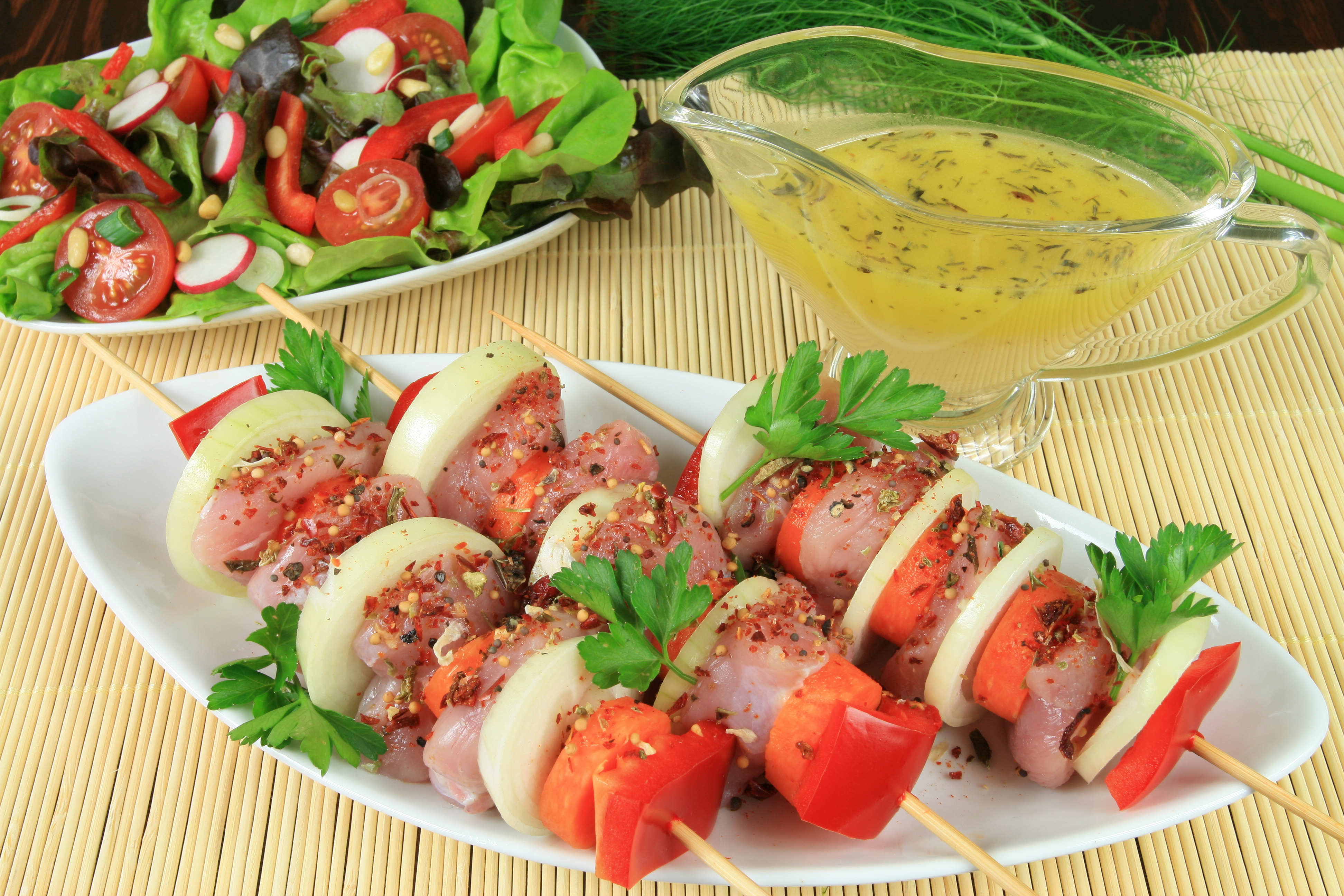
There are several uses for the various oils on the market. A common use for these oils is salad dressings or vinaigrettes. Oils can add an excellent flavor to a dressing, and they aren’t overly complicated to make at home. It is like adding mayonnaise to your salad but much healthier. Adding the right oil can add to the nutritional value of your salad. For example, grapeseed, almond, and avocado oils will add an abundance of vitamin e. There are also some oils that you should stay away from when adding to a salad dressing. Such as safflower or cottonseed oil.
You should also pay very close attention to fat content when adding oil to a salad. There are good fats, and there are bad fats. I am sure you’ve heard this before. Saturated fats and trans fats can raise your cholesterol. Trans fat, in particular, increase your low-density lipoprotein (bad cholesterol) and decrease your high-density lipoprotein (good cholesterol). Oils that have more than 4 grams of saturated fat per tablespoon should not be used very often. The American Heart Association suggests that you lower your trans-fat intake to less than 7 percent of your caloric intake. Polyunsaturated and monounsaturated fats have a different effect. They are known to improve cholesterol levels. Other factors may include heart health, risk of cancer, and obesity. What’s the point of eating a salad if you are adding ingredients that are bad for your health? This is why you must be very careful with your oil selection for a vinaigrette dressing.
How to Make Your Own Salad Dressing
A vinaigrette is a dressing made with oil and vinegar. All it requires is vinegar, your choice of oil, salt, pepper, and any additional spices that you would like to flavor the dressing with. It is one-part vinegar and three parts of olive oil; all the spices are added to taste. There is an overview on how to choose the healthiest oil below. As for vinegar, I would recommend wine or rice vinegar. Other options include apple cider vinegar, balsamic vinegar, sherry vinegar, or lemon juice. You are going to need to play with these a bit to find what you like the best, but I would start out with the more straightforward kinds of vinegar before getting too experimental. Oil and vinegar are the only real requirements for making a vinaigrette, but why not add some extra flavor. This is where the salt and pepper come in to play. However, you can also add fresh herbs like basil, cilantro, mint, or thyme; grated cheeses like parmesan, gorgonzola, or feta; sugar, honey, garlic, or ginger. Basically, you can add any flavoring that you like but don’t go too crazy and ruin the vinaigrette.
After you get all of your ingredients together, throw them into a blender. This will force the oil and vinegar to stay together. After that, transfer the vinaigrette to a jar, and you are good to go. You now have your own homemade vinaigrette. You may need to do a little taste testing before adding it to your salad. If the vinaigrette needs adjusting, just add what’s needed and throw it back in the blender. Keep the leftover vinaigrette in a sealed jar and be sure to refrigerate. The dressing has about a three-day shelf-life. So, what are the best oils to use for this vinaigrette?
5 Healthiest Oils for a Salads
Extra Virgin Olive Oil There has been a lot of speculation over the years about the healthiness of olive oil.
However, extra virgin is the highest caliber of olive oil. Extra virgin olive oil is made without heat pressing or any added chemicals. It is great for a vinaigrette because it has a delicate taste and is not overwhelming. It is high in monounsaturated fat, which makes it quite heart healthy. It has high vitamin E and K content, as well as being loaded with antioxidants. It has oleic acid, which is linked to reduced inflammation. This helps to help prevent heart disease, cancer, diabetes, and arthritis.
Avocado Oil
I know it seems like avocado oil is great for everything, and that’s because it basically is. Avocado oil is a healthy cooking option in pretty much any dish you can think of. Avocado oil is derived directly from the avocado, and the cold press version is something you should definitely keep in your cabinet. Avocado oil has low levels of oxidation, high monounsaturated fat levels, proper levels of antioxidants, and the presence of phytosterols. Phytosterols help to lower harmful cholesterol levels. They fight for the same enzymes in your gut as cholesterol, which prevents bad cholesterol from being absorbed. Avocado oil is rich in Oleic Acid, which is a heart-healthy fat. It helps to regulate cholesterol levels and has glutathione, which boost the immune system. It also enhances the absorption of the essential nutrients due to the presence of carotenoids. Avocado oil is such a versatile oil with various health benefits. As long as you like avocados, the oil can do no wrong.
Walnut Oil
Walnut oil is an oil derived from the walnut. The oil adds a very unique flavor to a vinaigrette and boasts some great health benefits. Walnut oil contains a large amount of omega-3 fats, which is one of the good kinds of fat. It is also rich in antioxidants. These two factors contribute to its viability in heart health and the prevention of cancer. Walnuts have also been known to improve brain function. Studies have shown that consistent consumption of walnut oil reduces the likelihood of Alzheimer’s disease. This is also linked to the notable presence of antioxidants in walnut oil. The potassium found in walnut oil has also been known to defend against hair loss, speeding up the process of hair growth. It also has plenty of vitamins such as vitamins B-1, B-2, B-3, and E. However, anybody that is allergic to nuts should stay away from nut oils. You have been warned.
Almond Oil
Almond oil is an oil made from the almond. Almond oil has a mild, nutty flavor that adds a nice twist to a vinaigrette. Almond oil is high in unsaturated fats. This makes it ideal for reducing heart disease and obesity. Mainly, it is high in monounsaturated fat. This type of fat helps to lower high blood pressure. Monounsaturated fat has been known to increase HDL levels, which is the good kind of cholesterol. Almond oil is also said to lower your bad cholesterol, due to its low LDL (low-density lipoproteins). LDL is considered bad cholesterol because it clogs the arteries.
Peanut Oil
Peanut Oil also goes by the name groundnut oil. It has an underwhelming taste, which makes it suitable for a variety of dishes. In a vinaigrette, it goes excellent with a kale or Thai salad. Peanut oil is naturally trans-fat free and low in saturated fats. Like olive oil, it is high in monounsaturated fats. This makes it a very heart-healthy oil. It also has the presence of phytosterols, which help lower harmful cholesterol levels. Peanut oil is also known to increase the blood flow in your body.
5 Unhealthiest Oils for a Salads
Soybean Oil
Soybean oil like canola oil is highly refined and goes through the bleaching and deodorizing process, which does not make for a healthy oil. It is also high in polyunsaturated fat, which makes it prone to oxidation. Soybean oil is a popular oil used in fast-food restaurants and has been heavily linked to obesity. This oil definitely has its place, but it isn’t in your salad.
Corn Oil
Corn oil is also very processed but is high in polyunsaturated fat. It is very high in omega-6 fatty acids, which can ruin the enzymes that help with your immune system and inflammation. Omega-6 fatty acids are not always harmful but must be consumed in perfect balance. Our omega-6 to omega-3 ratio should be about 4 to 1. However, with corn oil, the ratio is about 46 to 1. Corn oil is also made with genetically modified (GMO) corn. While corn oil does have a few health benefits, the cons far outweigh the pros. However, it does have a pretty high smoke point. With that said, it would be better for frying than a vinaigrette.
Safflower Oil
While safflower oil can be used for a vinaigrette; there are so many better options. Safflower oil is made from the safflower. This is a yellow-spiky plant, and the seeds are used to make the oil. Safflower oil is not necessarily an unhealthy oil, but it isn’t great for a vinaigrette. It isn’t very high in omega-3 fatty acids, which is essential. Omega-3 fatty acids help prevent heart disease and bad cholesterol. Safflower oil has been linked to unhealthy weight gain, which is not what you want when consuming salads. Like corn oil, it has a high smoke point and is a good oil to use for frying. However, you can do better for your salad dressing.
Palm Oil
Palm oil isn’t a healthy option when making a vinaigrette. The oil mainly consists of saturated and monounsaturated fats. The high saturated fat content makes it prone to causing harm to your cardiovascular health. This can ruin your entire salad. Also, worth mentioning for you environmentalists, palm oil production is said to be very harmful to the planet. We should all keep this in mind when purchasing a bottle.
Cottonseed Oil
Cottonseed oil is another one of those highly controversial oils. Cottonseeds contain a natural toxin named gossypol. Gossypol has been connected to infertility and liver disease. In order to remove this toxin, it must be refined. Refined oils are not as good for you, and unrefined cottonseed oil is mainly used as a pesticide. Using cottonseed oil for your vinaigrette is basically a loose-loose situation. If you already have a bottle, just get rid of it altogether.
Eating a salad without dressing is nearly unheard of. However, with these tips, you can make your own at home and really make it work for you. Ranch dressing isn’t going to help with your health, but a vinaigrette just might.


